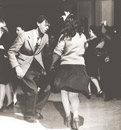By Carl Zebrowski
Bernadette Mahoney stood in the ballroom of the Vendome Hotel in Boston. A sailor walked up to her and invited her to dance with him in a jitterbug contest. He was nice, and she accepted. But after they moved onto the dance floor, she realized he was drunk. “Boy,” she recalled, “I had to do some fancy footwork to keep from getting stepped on.”
Mahoney stuck to the plan. “Oh well, I thought, we will be eliminated right away.” One by one, the judge tapped dancers on the shoulder to leave the floor. Soon there were only three couples left, including Mahoney and the sailor. The crowd had the final say, and Mahoney and her drunken partner won. “Maybe people thought it was a new dance step,” she offered. “But it was more likely they thought we were a couple of clowns acting crazy. Who knows? Anyway, I won a pair of white leather gloves and all my toes were intact.”
 is a catchall term for several bouncy, up-tempo dance styles also known collectively as swing dancing (“swing” was a common name for the music that accompanied the dance, and “jitterbugs” were what singer Cab Calloway said the dancers looked like out on the floor). Swing dancing really came into its own when the United States entered the war. As GIs flocked to port cities and railroad hubs around the country on the way to service overseas, they sought parting moments of fun and companionship. They found it at dances held in nightclubs and ballrooms and at volunteer-staffed USOs and Stage Door Canteens. Dancing was the perfect activity for them, offering temporary escape and a socially acceptable way to initiate physical contact with girls they’d never met.
is a catchall term for several bouncy, up-tempo dance styles also known collectively as swing dancing (“swing” was a common name for the music that accompanied the dance, and “jitterbugs” were what singer Cab Calloway said the dancers looked like out on the floor). Swing dancing really came into its own when the United States entered the war. As GIs flocked to port cities and railroad hubs around the country on the way to service overseas, they sought parting moments of fun and companionship. They found it at dances held in nightclubs and ballrooms and at volunteer-staffed USOs and Stage Door Canteens. Dancing was the perfect activity for them, offering temporary escape and a socially acceptable way to initiate physical contact with girls they’d never met.
The Swing Era had begun in the 1930s, when Americans were trying to forget the Great Depression. Dancing to upbeat music seemed to help. Swing became more popular as the decade went on, and after the repeal of prohibition, crowds began to outgrow the speakeasies where the dancing had started. The band performances moved into bigger halls to accommodate more and more dancers. The bands had to get bigger, too, to fill those halls with more sound. The result was the big band, a sizable orchestra built around saxophones, strident brass, and drums.
Then came the war. Once the initial shock of being attacked wore off, nightclubs did a booming business. “When the war first broke out, the feeling was gloomy,” remembered John McDonough, a seaman from the Pittsburgh area. “But when things became routine, people enjoyed themselves. The exception was when someone we knew got killed in the war.” Clubs and halls drew crowds with top bands, booze, and the often-kept promise of a good time. A night of carousing didn’t come cheap, but because of the boom in war-related jobs, Americans suddenly had higher incomes than ever, and with war rationing, there was less to spend their money on. The 50-some clubs in New York City grossed more than $85 million in 1942 alone. Celebrity bands led by Benny Goodman, Duke Ellington, and Glenn Miller rocked the larger houses, especially in the big cities. Small-time outfits played smaller facilities all across the country.
Dancers who were too young to get into establishments that served alcohol gathered at teen recreation centers, places designed to keep kids off the streets and out of trouble. Unlike the adult clubs, these facilities offered cheap nights out, often providing the same music the adults danced to, but via records on a jukebox rather than live bands. The kids could often play pool or poker as they drank Coke and ate popcorn, but it was the dancing and the mingling that brought them out.
As the war neared its end, so did big bands and swing dancing. Prohibition-inspired activists tried to persuade whoever would listen that drinking and dancing were setting up the country for a big hangover once the war ended and everyone woke up again to normal life. In an effort to crack down on the offending behavior, the federal government cranked up taxes on clubs and cabarets to a whopping 30 percent. Many of the places went out of business. Meanwhile, star singers such as Frank Sinatra had begun leaving their big bands to start solo careers, making music that was more for listening than for dancing, and the public was eating them up. Big bands and the dancing they inspired soon went the way of silk stockings and steam locomotives.
Photo credit: Library of Congress
Copyright 2007 310 Publishing, LLC. All rights reserved.


FOLLOW US »
